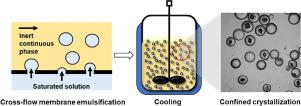Chemical Engineering and Processing: Process Intensification ( IF 3.8 ) Pub Date : 2021-11-30 , DOI: 10.1016/j.cep.2021.108751 Soojin Kwon 1 , Kiran Mathew Thomas 1 , Richard Lakerveld 1

|
Solution crystallization processes are challenged by the need to control crystal quality attributes such as the crystal size distribution (CSD). Emulsion crystallization is an attractive process intensification strategy to control crystal quality attributes through miniaturization. Droplets of an emulsion can act as tiny crystallizers by confining crystals so that crystal nucleation and growth are limited by the droplet size with available supersaturation. This work presents a novel process concept based on the integration of membrane emulsification and solution crystallization. A water-in-oil emulsion is created through membrane emulsification and glycine is crystallized inside droplets by cooling. The process is characterized in terms of the droplet size distribution, crystal number density, and CSD as a function of the emulsification method and supersaturation. Large and monodisperse droplets obtained from membrane emulsification can achieve a narrow and predictable CSD with higher productivity compared to a mechanical emulsification method. The crystal number density is strongly affected by the initial supersaturation when using membrane emulsification but not the final CSD. In contrast, the CSD changes with supersaturation when applying a mechanical emulsification method. The CSD obtained from a conventional bulk crystallization process is broader and lacks the control imposed by the uniform droplets from membrane emulsification.
中文翻译:

集成膜乳化和溶液冷却结晶以获得窄且可预测的晶体尺寸分布
溶液结晶过程面临着需要控制晶体质量属性(例如晶体尺寸分布 (CSD))的挑战。乳液结晶是一种有吸引力的工艺强化策略,可通过小型化来控制晶体质量属性。乳液的液滴可以通过限制晶体来充当微小的结晶器,从而使晶体成核和生长受到具有可用过饱和度的液滴尺寸的限制。这项工作提出了一种基于膜乳化和溶液结晶一体化的新工艺概念。通过膜乳化产生油包水乳液,甘氨酸通过冷却在液滴内结晶。该过程的特征在于液滴尺寸分布、晶体数密度、和 CSD 作为乳化方法和过饱和度的函数。与机械乳化方法相比,通过膜乳化获得的大而单分散的液滴可以实现窄且可预测的 CSD,并具有更高的生产率。当使用膜乳化而不是最终的 CSD 时,晶体数密度受初始过饱和度的影响很大。相比之下,当应用机械乳化方法时,CSD 会随着过饱和而变化。从传统的大量结晶过程中获得的 CSD 范围更广,缺乏由膜乳化产生的均匀液滴施加的控制。当使用膜乳化而不是最终的 CSD 时,晶体数密度受初始过饱和度的影响很大。相比之下,当应用机械乳化方法时,CSD 会随着过饱和而变化。从传统的大量结晶过程中获得的 CSD 范围更广,缺乏由膜乳化产生的均匀液滴施加的控制。当使用膜乳化而不是最终的 CSD 时,晶体数密度受初始过饱和度的影响很大。相比之下,当应用机械乳化方法时,CSD 会随着过饱和而变化。从传统的大量结晶过程中获得的 CSD 范围更广,缺乏由膜乳化产生的均匀液滴施加的控制。











































 京公网安备 11010802027423号
京公网安备 11010802027423号